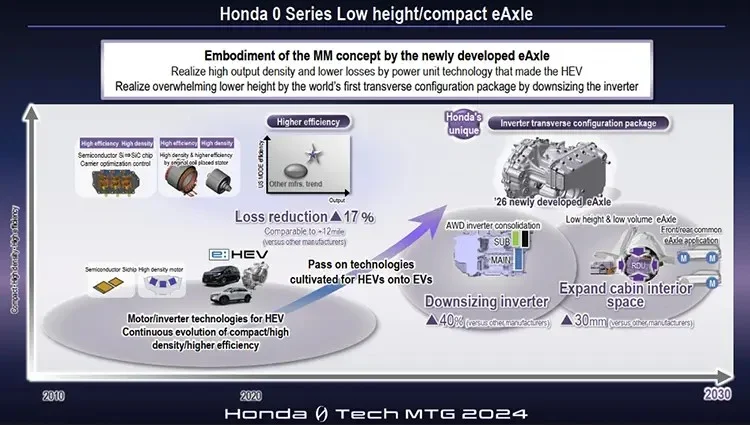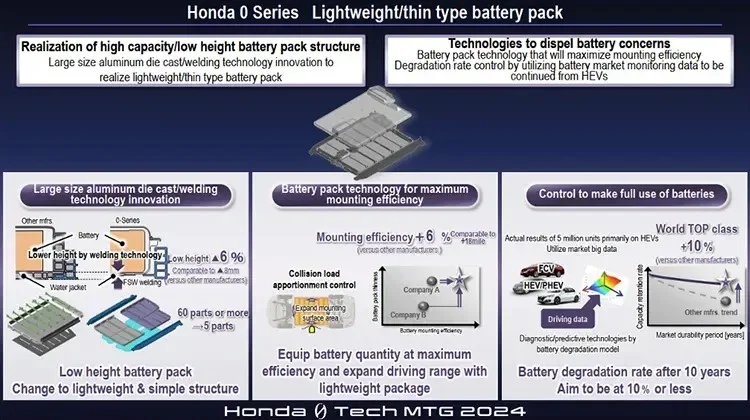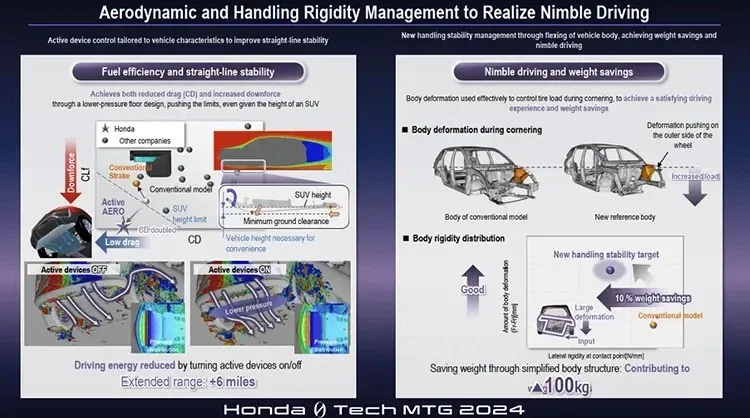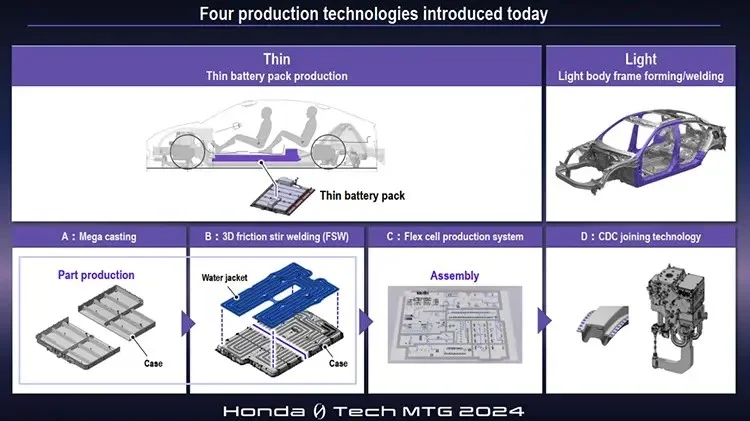Honda plans new range of 0-Series ZEVs for global markets from 2026

Honda Motor Company introduced some of its next-generation technologies at its “Honda 0 Tech Meeting 2024” in Tokyo this week, as the company prepares to launch a new range of 0-Series zero-emission vehicles in global markets from 2026.
The Japanese automaker said it plans to launch seven new 0-Series models globally by 2030, including small-, medium- and large-size models. The 0-Series range is being developed based on the company’s “Thin, Light and Wise” approach to EV development, which focuses on five core values:
- Artistic design that resonates with people
- Automated Driving/Advanced Driver Assistance Systems (AD/ADAS) that ensures safety and peace of mind
- New value of EV as a “space” for people made possible by the internet of things (IoT) and connected technologies
- The joy of driving with the feeling of oneness with the vehicle
- Outstanding electricity efficiency performance
Honda unveiled two new 0-Series concept models at the Consumer Electronics Show (CES) in Las Vegas earlier this year earlier, the 0-Series Saloon and Space-Hub. The company confirmed its plans to launch a production model of the Saloon in 2026, which it says will be close to the concept model and it will be positioned as the flagship model of the Honda 0 Series.
Honda also plans to launch a new 0-Series model at CES 2025 this coming January, featuring some of the technologies and electrification concepts introduced at this weeks Honda 0 Tech Meeting, including:
- Thin and Light. With the “Thin” development approach, Honda aims to offer “new value for EVs as a comfortable space featuring an original design with a low vehicle height and short overhangs”. With the “Light” development approach, Honda aims combine its “sporty driving unique only to Honda and the world’s top-class electricity efficiency performance”.
- A new dedicated EV platform, manufactured using 2.0 GPa grade hot stamping material (ultra-high strength steel plate), will be the basis of the new 0-Series range. The company claims the new EV platform allows for thin and low-height styling, as well as offering additional safety. It will use a thin battery pack and a newly developed compact e-Axle. Honda’s low-floor technology enables a low center of gravity and low inertia by placing heavy components low and in the center of the vehicle which it says helps stabilise “vehicle behavior” and enables “sporty driving”.
- Newly compact e-Axle, described ascompact and highly efficient, developed thanks in large part to the company’s experience in developing hybrid-electric vehicles systems. The inverter size was reduced by approximately 40% and placed next to the motor, allowing for a horizontal layout which helps maximise cabin space.

- Thin battery pack. The IPU (battery) case is around 6% thinner than in current EVs thanks to the use of mega-casting and 3D friction stir welding (FSW) technologies. The structure is designed to disperse the impact in the case of a collision while saving space and reducing weight. Honda said it is looking to limit the degradation of battery capacity (range) to less than 10% after 10 years of use by applying battery degradation diagnosis and prediction technology that utilizes driving data from 5 million Honda vehicles, mostly HEVs.

- Active aerodynamic system, which automatically activates the front aero deflector according to the vehicle speed and other factors. The front aero deflector is installed under the floor to reduce air resistance for all vehicle body types. In addition to reducing driving energy without compromising daily usability, this system will enable the vehicle to demonstrate high downforce performance and contribute to an increase in straight-line stability of the vehicle.
- New body rigidity with high driving stability and lightweight. Honda claims the new 0-Series platform offers a “sporty and exhilarating driving experience” by adopting a new steering stability index, which “provides the ability to flex the vehicle body to control load on each tyre during cornering. The simplified body structure also contributes to an overall vehicle weight reduction of approximately 100kg compared with initial Honda EVs.”

- Wise. Honda said will create software-defined vehicles (SDVs) using an in-house developed operating system (OS), which it says will be in line with the advancement of connected technologies. The 0-Series will also come with AD/ADAS (Automated Driving/Advanced Driver Assistance Systems).

Source from Just Auto
Disclaimer: The information set forth above is provided by just-auto.com independently of Alibaba.com. Alibaba.com makes no representation and warranties as to the quality and reliability of the seller and products. Alibaba.com expressly disclaims any liability for breaches pertaining to the copyright of content.




